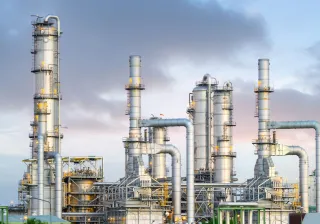We need electrofuels for reducing emissions from transport and P2Chemicals for cleaner products from the chemical industry. Both are produced with Power-to-X technology. However, someone must first create the needed technologies and build the production facilities. There are export opportunities for Finnish companies in electrofuels and chemical industry products and in process technologies. Joint Power-to-X demonstration projects that bring together the companies of the whole value chain are an important step on the way to commercialisation.
Stop for a moment to look at the things around you. You might be able to identify many products made from oil, such as various plastics. If the goods that you see are not made of oil products, oil has probably been used at least in their transport, and in some cases also to provide energy in their production. The elephant is in the room even if we ignore it.
Fossil oil needs to be phased out in order to mitigate climate change. Carbon dioxide capture, for example from industrial emissions or directly from the air, and hydrogen produced from water using clean electricity have become a hot topics as almost unlimited sources of raw materials.
Electrofuels as well as P2Chemicals still face legislative hurdles and barriers concerning competitiveness. In addition, there is huge demand for additional clean energy. The facilities needed for producing pure hydrogen and for carbon dioxide capture are still in rather early stages. How can the world's oil refineries and the petrochemical industry be renewed?
The production potential for electrofuels in the Nordic Countries
A project funded by the Nordic Energy Research organisation compared potential locations in the Nordic Countries where electrofuels could be produced. Scenarios were examined in which the production of Nordic electrofuels would be about 25 terawatt hours by 2045. This corresponds roughly to the entire annual consumption of diesel fuel in road transport in Finland.
However, it looks like there will be no shortage of raw materials for electrofuels in the Nordic Countries. Of course, plenty of additional clean electricity is required. If the electricity needed in the production were to be covered completely by wind power, the Nordic Countries would need 15 gigawatts more wind energy, which is 6-7 times more than Finland's current wind power capacity.
Electrofuels and the emission goals for transport
Energy consumption of fuels in domestic transport in Finland is about 49 terawatt hours a year, 93% of which is consumed in road transport. On top of this comes the electricity used in transport. Direct electrification both reduces emissions while cutting the total need for energy in transport. The Finnish road map for fossil-free transport shows ways in which emissions from transport are to be cut in half by 2030. According to the road map, the availability and impact of electrofuels will be evaluated in the next phase.
In Finland, there could be several production facilities for electrofuels in the early 2030s. Annual domestic production of 250 million litres could cover around 5 per cent of the energy used as fuels in domestic transport. The significance of electrofuels in the reduction of domestic emissions might not be of much significance before 2030, but we must keep the long-term goal in mind. Zero emissions by 2045 would mean that no fossil-based oil would be used as fuel in domestic transport.
As electrification increases, the need for electrofuels can be assumed to shift especially in the direction of heavier modes of transport where direct electrification is not easily applicable. On the global scale demand for electrofuels will be considerable as according to estimates about 70% of the world’s energy for transport will come from fuels as late as 2050. Emission cuts from domestic transport should be utilised as a springboard to commercialise novel technologies for export.
E-fuel is the key electrofuel project in Finland
The E-fuel project of the Neste Veturi programme was launched at the beginning of 2021. It aims at the large-scale production and commercialisation of electrofuels and involves 15 partners. E-fuel is an investment of more than 6 million euros in the electrofuels development.
One of the goals of the project is to improve the production efficiency in converting electricity to fuel by 10-15 percentage points compared with the current technologies. A key enabler for this is combining high-temperature electrolysis with carbon dioxide capture and a hydrocarbons synthesis unit. Meanwhile, new production technologies for electrofuels are to be commercialised together with companies in the value chain. For example, Convion and Elcogen are developing high-temperature electrolysis in their own parallel projects.
E-fuels will also demonstrate the end use of produced electrofuels in heavy vehicles. New possibilities for reducing carbon dioxide and local emissions are being sought when knowledge in electrofuels, vehicle technology, and emission control are combined.
Turning electricity and carbon dioxide into clean chemicals
In the BECCU project funded by Business Finland, VTT and a large group of Finnish companies are working together to develop a production process that allows the captured carbon dioxide from bioenergy plants to be used as raw material for specialty chemicals, namely polyols, together with clean hydrogen. If the project succeeds in its goals, it will be possible to manufacture polyurethane used in the construction industry, glues, and in many goods in everyday use, out of polyols produced in an environmentally friendly manner.
Meanwhile, the ICO2CHEM project led by VTT has now been set up in the Park Höchst industrial park in Frankfurt. In the project, the manufacture of chemical products will be demonstrated, including paraffin oils and waxes used in insulators and coatings from hydrogen and carbon dioxide side streams that are available in the area. The project partner Altana is testing oils and waxes produced in the project in its own product applications.
With respect to P2Chemicals, the array of potential Power-to-X products is truly extensive. From the point of view of profitable business, it would be reasonable to start commercialisation with products of higher value that have sufficient prerequisites for economic success.
Through demonstrations toward commercial installations
Building large production facilities of the chemical industry can cost hundreds of millions or billions of euros, so the technology needs to be well understood before a decision for a new plant is made. In demonstrations new technologies are developed, and information is collected for deciding on an installation in the next scale category. It is important to focus on demonstrations right now, since they are paving the way to commercial plants.
A demonstration is usually preceded by years of technological development from laboratory tests to smaller pilot scale. Due to long-lasted commitment in research and development, we can develop winning technologies from Finland for the world market which can enable producers to stop using fossil oil. Meanwhile, the technologies and construction of these new plants can be turned into a new success on the export market.
So how can the world's oil refineries and the petrochemical industry be renewed? The answer is the same as the one for the old joke about how to eat an elephant: one piece at a time. One day when we take another look at the goods that surround us, we will notice that the elephant is no longer in the room.









